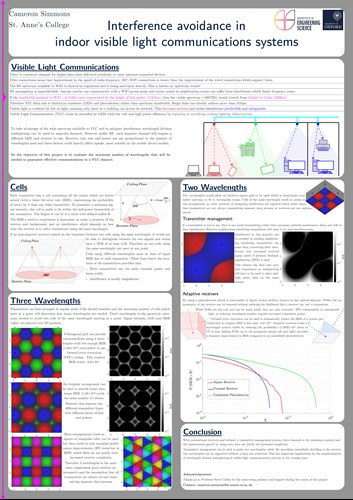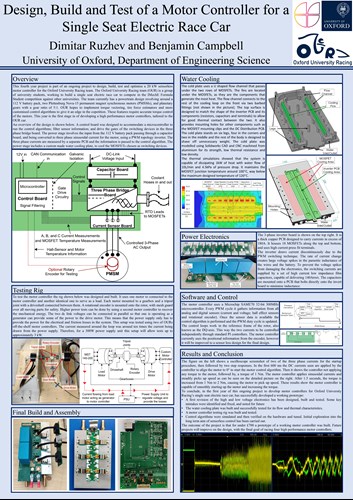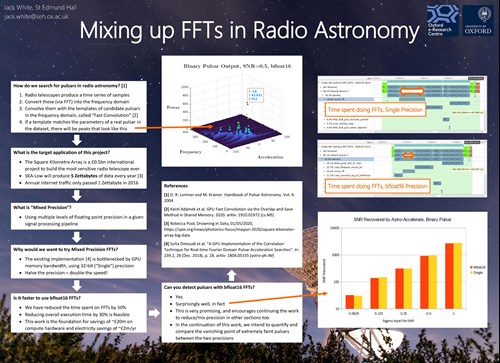SEARCH BY KEYWORDS, SUBJECT, PEOPLE AND HIT ENTER
Interference avoidance in indoor visible light communications systems
Cameron Simmons, St. Anne's College
Visible light communications (VLC) has been proposed as a system to run in parallel to or selectively replace radio frequency (RF) WiFi. It has been demonstrated that by modulating LED lighting systems at high frequency it is possible to provide links exceeding the capacity of WiFi.
The unlicensed, broad frequency spectrum of VLC means that data rate is limited only by hardware development, which is constantly progressing. VLC also has the potential to provide greater data rate density (support more users per unit area with higher data rates) and security than WiFi. The small cells ("attocells") used by VLC systems can interfere significantly when using the same wavelength simultaneously. Wavelength division multiplexing (WDM) can be used in VLC to allow multiple access to a network from separate neighbouring cells. Alternatives such as code division multiple access or time division multiple access incur a reduction in data rate for each user when active and do not take advantage of the broad frequency spectrum.
The arrangement of transmitters and the wavelengths they use determines the effect of interference. Neighbouring transmitters using the same wavelength will result in catastrophic interference at the boundary between their cells, so that a user at this boundary would be unsupported. The more spatially separated cells using the same wavelength are, the less interference is present in each channel. This can be achieved by adding wavelengths to the standardised set available to WDM.
However increasing the number of wavelengths chosen for WDM during standardisation has a significant effect on the hardware necessary to use VLC, most notably at the receiver. Unlike RF systems, each separate wavelength will require separate receiver architecture with a different optical filter. Each added wavelength therefore increases the cost, power and complexity of the receiver. As a juvenile technology these factors could be prohibitive of uptake, most significantly to the mobile device market where power must be provided by a battery.
Therefore this project seeks to establish the minimum number of wavelengths which must be used to ensure coverage of any room with interference mitigated to acceptable levels. This is done by the development of a simulation of the VLC channel.
This simulation is then applied to a series of developed candidate arrangements of transmitters to demonstrate how the statistics of channel bit error rate (BER) change with the number of wavelengths used. Once the minimum number of wavelengths is established, modifications to the VLC channel are proposed which may be used to reduce this minimum further.
Motivation
The goal of this project is to reduce the cost of detecting binary pulsars. Binary pulsars are interesting to physicists as they are one of the few places where it is possible to study general relativity under the conditions of the strong-field regime. Also, the binary nature of these systems allow physicists to make more accurate inferences about the mass of the constituent neutron stars. This project is being completed in the context of the Square Kilometre Array radio telescope, a £500m international project to build an extremely sensitive radio telescope, which will produce terabytes of data every second that will need to be analysed. The compute hardware required to process this amount of data will form a significant (≈15%) fraction of the overall budget, and therefore it is important that the software is not performing unnecessary computations, resulting in fewer pulsars being detected, more money being spent and the project consuming more energy.
Technical goals
This project will entail implementing mixed precision in the Fourier Domain Acceleration Search (FDAS) section of the existing data processing pipeline, Astro-Accelerate. This is a GPU accelerated software package, developed at Oxford. Astro-Accelerate previously used FP32 precision in all FDAS floating point calculations. The goal is to determine whether using 16 bits of floating point precision leaves sufficient sensitivity to detect new binary pulsars, and how to allocate those 16 bits. This will involve systematically studying signal degradation over a range of realistic synthetic cases, and the effect that mixed precision has on them. A secondary goal of the project is to document the experience of converting an existing scientific codebase to mixed precision. As new computational hardware accelerators are being released with support for novel datatypes, it is important the benefits/tradeoffs of implementing mixed precision are understood.
Conclusion
The results show that you can use bfloat16 FFTs to process this data, without significant loss in sensitivity. To realise the 50% speedup was not a trivial task, as mixed precision inherently introduces extra computations to convert the data at the boundaries where the precision “mixes”. As part of this project I have demonstrated an low-level optimisation, at the scale of manipulating individual bytes within each floating point number in the GPU memory that allows the conversion to happen without a performance penalty.
I will be continuing this work in my DPhil with my 4YP supervisor, Prof. Wes Armour.



